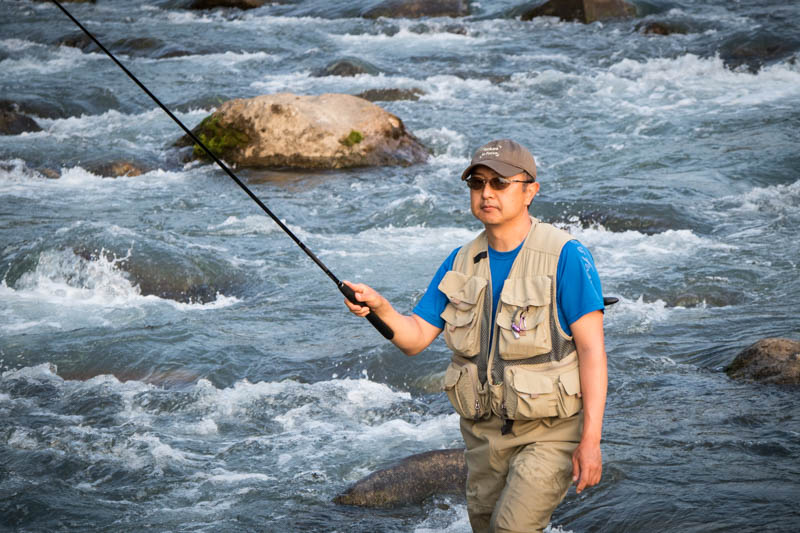
Ok, you got me… I admit that it’s HIGHLY unlikely that you’ll ever face unbearable public shame or be banned from social media for getting out of your depth in a technical tenkara discussion. BUT, there are so many aspects of tenkara that are not recognised and/or not talked about in the west – and yet include tons of incredibly effective techniques – that it seems crazy to keep them quiet.
We’ve really benefited from finding out about these things and taking them away to use on our home rivers; so we thought you’d also like to have access to those insider advantages too.
In this first article I’ll show you some ways to elevate your line-control skills so that you can kick your presentation and success up a gear. You’ll find out:
- What the loose change in your pocket has got to do with a disappointing lack of distance when presenting your fly
- Why many anglers can’t get a decent drag-free drift with a high rod tip (even though that is meant to be a major advantage of tenkara)
Let’s start with Change (the sort that does not “come from within”)
In Japanese stores, when you pay the cashier, you put your money on a small tray. The cashier then returns that tray to you with your change (largest notes on the bottom, arranged in ascending order with your receipt and then coins on the very top). This type of change is called “otsuri”. OK, great…but what has this got to do with fishing??
Well, apart from “O-tsuri” also being a polite word for “fishing”, many top-level tenkara anglers use otsuri (change) to describe a frustrating experience when fishing with a fixed line and a high rod tip.
Basically, when you try to fish at a greater distance than your skill or tackle allows – your rig and fly will settle at a much shorter range than you wanted. The difference between your initial landing point of your fly and where it finally settles into a workable fishing position is the “change” you get from your “overpayment” or over-ambitious original cast. That shortening of fishing distance that you have no control over is called otsuri.
There are two main kinds of otsuri – so let’s look at them now.
Rebound Otsuri
Although not an official term, I found it useful to invent it so I could separate out the different categories.
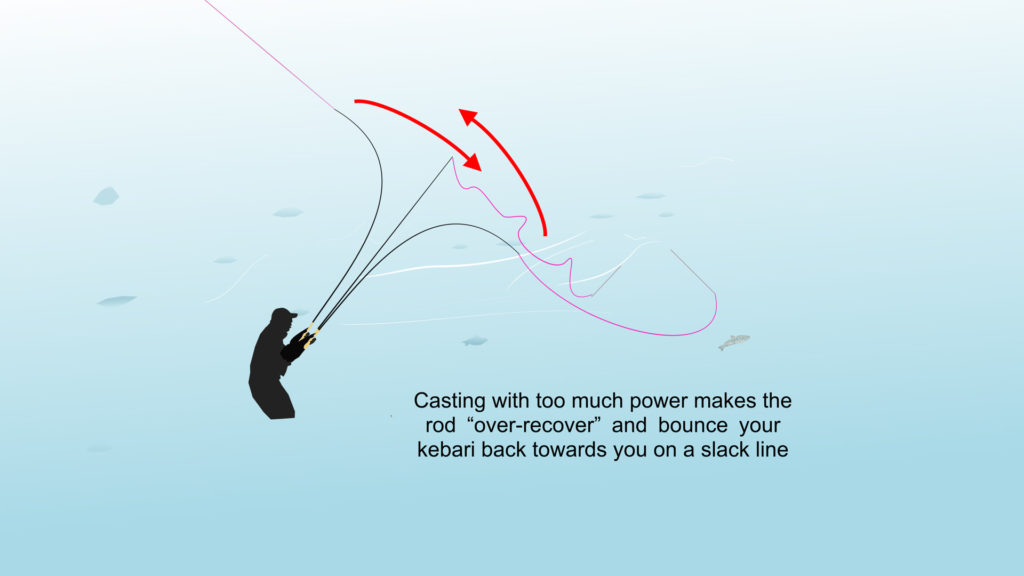
Basically, this is when too much force is used – either in the actual casting stroke or in the firmness of the “stop” at the end of the forward cast (the picture shows this pretty clearly I think). The excessive force means that the cast extends, but then bounces back and collapses in a wiggly heap in front of you…”you’ve put far too much to that cast; so here’s your change”.
This problem is one that Hirata-san is keen to help his students avoid as we’ll see in Season 2 of Tenkara in Focus…
It is important to remember that what counts as too much force is extremely variable. The perfect amount of force will vary with wind conditions, rod, line material/weight, rig setup (line and tippet length) and how heavy or streamlined your fly is. This means that at least part of the solution lies in varying how hard you cast your rig (and you should always try to use the smallest amount of force needed to get the job done). But I can also give you some more direct solutions to put in place. One of these involves changing the vertical angle of your cast – but I’ll cover that more fully in the section on “Drape Otsuri”).
As well as making sure that you are not simply cranking your casting stroke with too much force, you’ll need to soften your grip the millisecond after you make the “stop” on your forward cast. Because tenkara rods have the casting line fixed directly to the tip, you obviously can’t shoot line and use a rod-tip thrust (or other similar technique such as those used in the Italian style of fly casting) that helps to minimize the amount of the rod-tip “deflection” in western fly-rod casting. In other words, the line on a tenkara rod does exactly what the tip does – because it is tied directly onto that tip. When your grip remains tight throughout the whole casting stroke (including the “stop”); the rod tip and the whole line (not just the width of the loop) will rebound with too much force and with little control.
Softening your grip is an essential skill in tenkara – and it requires both practice and attention to detail before it becomes second nature. You should already have come across this idea in our free guide to the industry insider methods for testing tenkara rods (Click here for the guide if you need a refresher or first look).
The effect of that sudden slight relaxation of the hand is pretty much the exact opposite of standing hard on the brake pedal in your car and not releasing it – even when the forward momentum of the car has stopped. When you brake like that, you feel a horrible “rebound” lurch backwards and your passengers end up with their drinks all over their faces. Instead, right at the moment when you are about to come to a stop, just easing off the brake pedal damps out that lurch. This is EXACTLY the feeling we are going for when you relax your grip as you make the stop on your casting stroke.
When you don’t do that softening of the grip, I’ve already explained how the whiplash effect that you get from the rod-tip rebound destroys your ability to fish at full range as well as your accuracy. Instead, when you are able to master it, the smoothness that it adds to your loops will greatly increase your accuracy. It also means that, as your fly kisses down on the water, your line will remain fully extended. No more messy heap of wiggly casting line. Winner, winner; chicken dinner.
Having eliminated rebound otsuri, now you need to look at what I’ve decided to call “drape otsuri” and why it is important to you.
Drape Otsuri
If rebound otsuri is using too much strength, then drape otsuri is simply casting too far for your rig and the conditions. It is really common when folks transfer from regular fly fishing into tenkara. They’ve been sold on the idea that tenkara’s high rod tip (and long rod) means that they can eliminate drag by holding their casting line off the water – well away from those pesky complex currents. Only, when the rod tip is raised, their fly just comes skating back towards them in the opposite of a natural dead-drift.
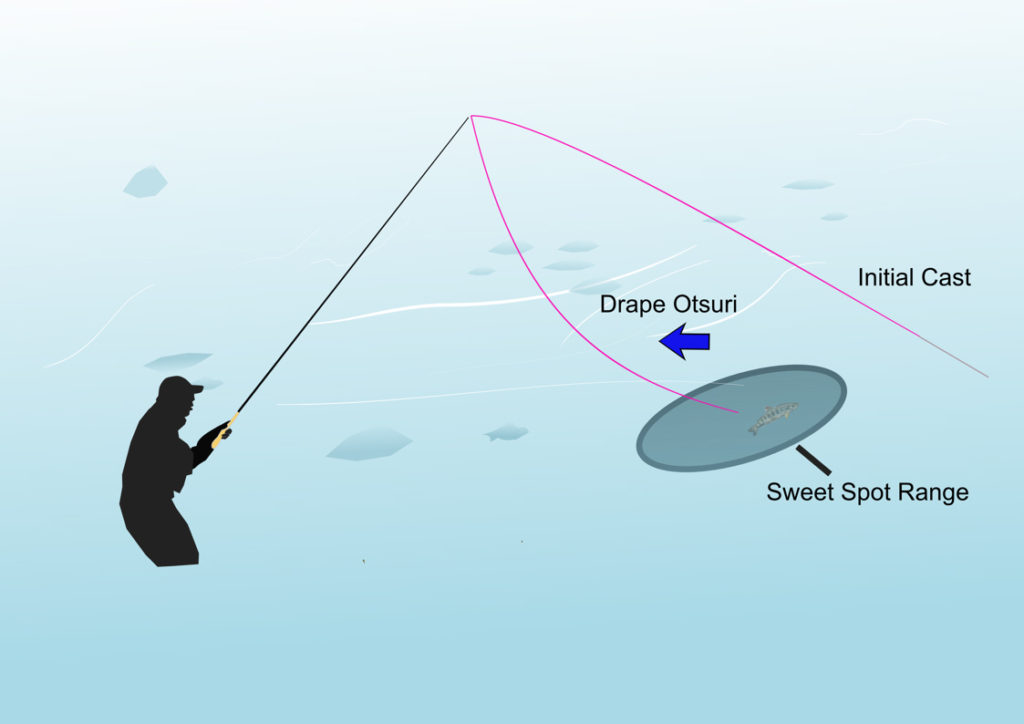
Here is the thing: gravity is a bitch – and the heavier your casting line the more it wants to hang straight down from your rod tip (and the more anger you may direct at gravity’s unreasonable behaviour). This means that, with a heavy line, you can only fish a short distance away from yourself. If you’re lucky, you’ll already have come across the cure for that on windless days in the form of Go Ishii’s video masterclass and my technical breakdown notes on fishing with #3 nylon level lines. Those vital resources are available to download here if you need them.Get Go’s Masterclass Here
Although there are many tweaks and hacks that help you solve this problem, a huge part of the answer lies in understanding the difference between the vertical angles of western fly fishing and tenkara. What I mean is, western fly fishing normally involves casting loops that travel out roughly parallel to the water’s surface. The line is cast out, horizontally, extends fully and is then laid down onto the water by tracking the line downwards with the rod tip as it falls onto the surface.
In tenkara, the cast is angled diagonally upwards on the backcast – and diagonally downwards on the forward cast. Using a fluorocarbon level casting line around a #3 or #2.5 on the Japanese scale, a vertical angle of around 45 degrees will work well (as a general guide). Done right, this means that the casting line and tippet all “unrolls” so that the very end of the tippet (with fly attached) is dropped onto the surface with a “Ta da!” inviting the fish to eat it. Your forward cast finishing position with the rod should be IDENTICAL to your “starting fishing” rod position. In other words, your fly and your whole rig should land in perfect fishing formation and you can go right to tracking your fly’s natural drift the instant that it lands on the water.
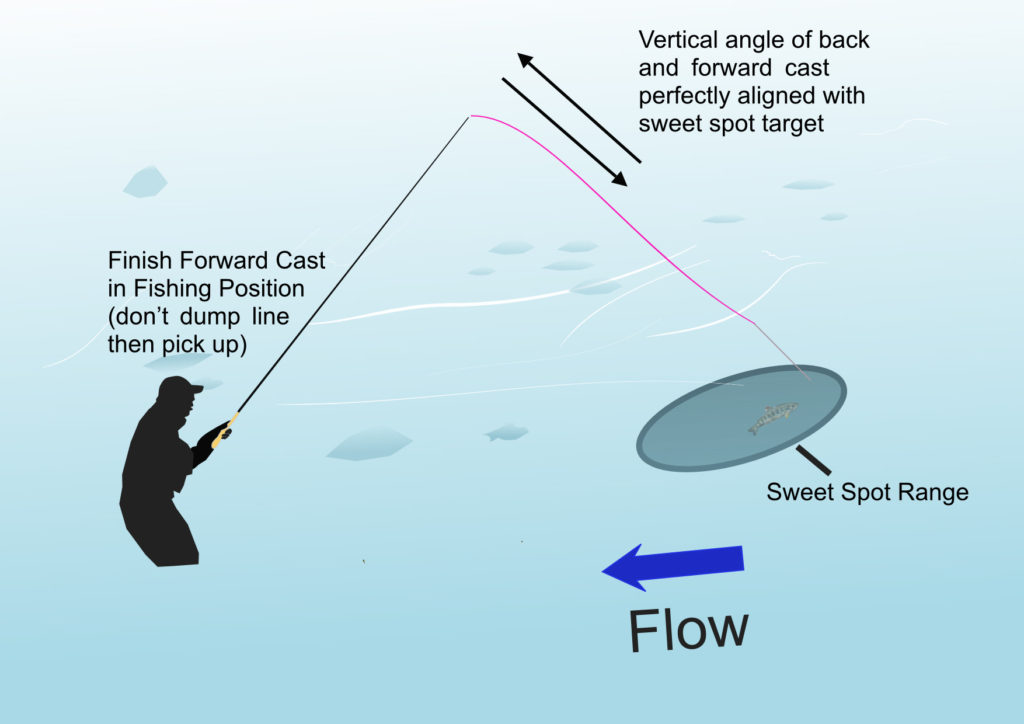
Now that you know what I mean by drape otsuri, I can fill in some more details on getting great dead drifts with the casting line held off the water.
Getting a proper dead drift with a high rod tip
I often see (and also hear about) many tenkara anglers struggling with getting a drift that they are happy with when using a high rod-tip position. They’ve heard all about how tenkara rods mean the end of mending the line and opening up wonderful drifts that are untroubled by tricky currents. Well, those things can be true – but you need to know a small number of things before it will work well for you under a range of conditions.
Of course, it would be easy enough to just tie a short enough piece of line onto your tenkara rod that would let you lower your fly vertically down onto the water. It could even be pretty effective if the conditions let you hide your rod from the fish (turbulent water and a complex broken background for example). But that is both pretty limited and also removes the joy of fly casting from the whole game.
If you want to be able to cope with a range of conditions and also enjoy the sensation of casting nice loops, here are three vital things you need to master:
- The “sweet spot” range for your rig that avoids too much Drape Otsuri (casting with the wind wherever possible always extends that range!!)
- Using the lightest level line that you can manage in the conditions (and that your rod is capable of casting)
- Understanding how the current can help you get the effect you desire
The first point has been well covered in the section on Drape otsuri (and rebound otsuri if you think about it) – but the second one could do with a little bit more detail. Of course, I’ve already flagged up the difficult to master but fantastic tactic of #3 NYLON level line. But that only works where there is almost zero wind blowing. From that lightest option, you still have a sliding scale of fluorocarbon level lines to work with (starting with the next-lightest after nylon): #2, #2.5, #3, #3.5. #4 and #4.5 as probably the lines that are most useful for tenkara.
The picture below shows the basic effect of using different diameter (weights) of level line (in this example, all lines made of fluorocarbon)…. Look out for Fujiwara-san’s inventive tactics that he has developed for minimising drape otsuri while maximising casting control which we’ll share in Season 2 of Tenkara in Focus.
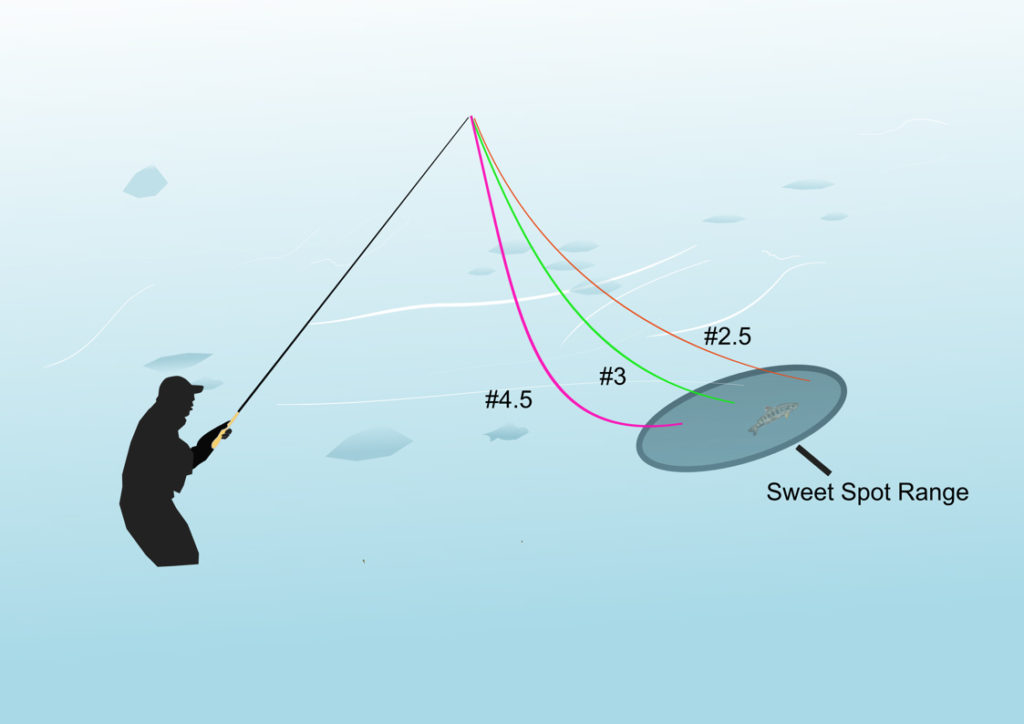
Because fluorocarbon is denser than nylon, you get a heavier line for the same diameter – or to put it the other way; for the same casting weight, your fluorocarbon line will be thinner and less affected by wind. Those “wind-cutting” effects and the excellent casting weight (and in the best ones, the perfect amount of stiffness and suppleness to smoothly transfer casting energy) of fluorocarbon are what makes it perfect for tenkara casting line.
Just be aware that depending on the action and performance of your rod, you will really struggle to cast certain lines (stiff rods need heavier lines to load them, super soft rods may be unable to cast heavier lines comfortably). You’ll also need to have a good casting stroke – whatever rod you own.
But it is backwards thinking to find it difficult to cast a #3 level line and then use that as a reason to tie on modified fly-line or similar heavy-line approaches…Or, even worse, to find it weird to use the shorter stroke and different timing of a Japanese tenkara cast – and use that strangeness as a reason to design a rod that lets you use western fly line with the slower timing and longer stroke of western fly casting…which is pretty much where Yvonn Chouinard/Patagonia seem to be…
Why not just use a budget, telescopic fly rod and reel? It is no more difficult to rig up and strip off a set length of line to fish with…and while I’m on the subject, bringing thick fly line back into the equation is presumably why you then need to start constructing stepped/tapered leaders instead of the simplicity of level fluorocarbon casting line and one step down to level tippet.
Why is there a problem with that? Well, there isn’t unless you are trying to reduce the effect of drape otsuri and get a significantly different presentation from those you get from western fly fishing. Regular fly fishing is wonderful, but there’s already tons of great gear for it and lots of knowledge about its techniques out there. This is about giving yourself a different opportunity (and in many cases, increased success).
Anyway, getting back to wind and wind-cutting – try wherever possible to USE the wind as something helpful – Not just something to be overcome by brute force and ignorance. Personally (and MANY top Japanese anglers also happen to agree…), I really do not like the metal level lines that are sometimes suggested for windy conditions. It is very limiting to automatically think that wind is there to be dominated, rather than used as an advantage. You just need to be aware that wind will either increase or reduce the “sweet spot range” for your fishing when you hold your rod tip high. With the wind in your face, your line will be blown back towards you (sometimes even right out behind you if it is especially strong wind). The opposite is, of course, true for a following wind…but if you’re signed up to our free tutorials, you’ll already have our top 5 tactics for beating or working with the wind in the free pdf you get when you sign up (Click here to subscribe if you’re missing out on the free email lessons)
Finally, the last piece of the “high quality drift” puzzle is how your fly and the river’s currents can help you.
If there was zero effect of the fly and also if the water was not flowing (and it was happening in a windless atmosphere), then all of the line-drape or sweet-spot diagrams above would just have a straight casting line, hanging vertically down from the rod tip.
Instead, you have got some cool things to play with that will help you. First of all, if you cast directly upstream, right after your fly lands, your casting line will “want” to gradually go from a sloping angle towards a vertically-hanging line. If you get the weight of the line right for the conditions, you can use this as a completely natural and automatic way to “track” the dead drift of your fly. You just need to hold the end of your casting line up off the water. In other words, by casting straight upstream, the movement of the current pushes your fly towards you and your line naturally swings down to maintain a light tension between your rod tip and fly.
Next, by using a wet fly (kebari) that has a stiff hackle, you can pick up and use certain current flows in a way that helps to stretch out your casting line and increase your reach. This could either be a static “anchoring” or it could be where a current slides off an underwater feature and pulls your fly slightly across stream and away from you as it travels downstream. By using as light a casting line as possible and also holding off as much line and tippet as needed, you can keep your kebari in that opposing flow – while holding your casting line out of reach of conflicting currents that would spoil your drift.
So there you have it, by finding the sweet spot distance and making sure that your final casting delivery position is exactly the same as your fishing position (no “correction” necessary after the cast lands); you will get awesome drifts. Knowing how the wind and water currents (and rig crucial rig details such as line material/weight and a rod that can cast that rig) will then nail down those advantages for you.
Maybe after reading this, you can see where the gaps in other information that’s out there lie? I really hope you can use this article to double your hook up rate next time you use the information on stream.
If you got something out of it, please Share it so your fishing buddies know that you’re in the know; and so you can ask them “Dude, do you even Tenkara?”.
Paul
